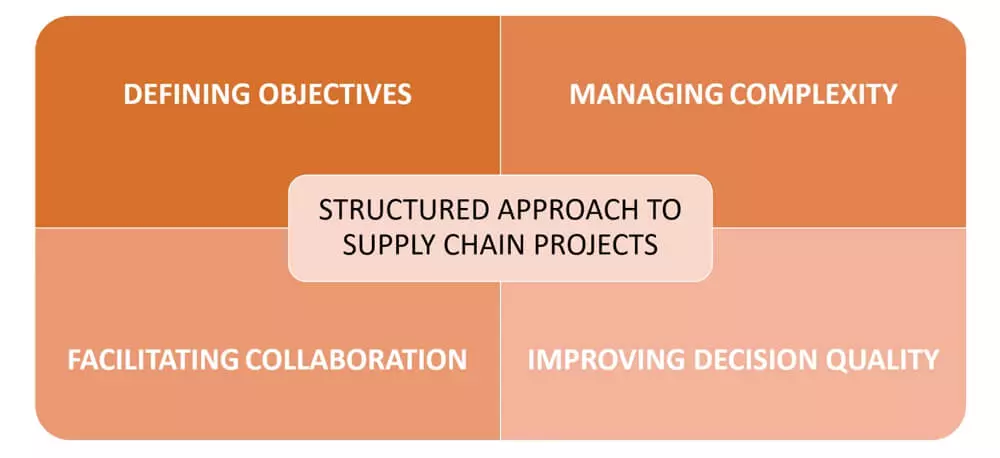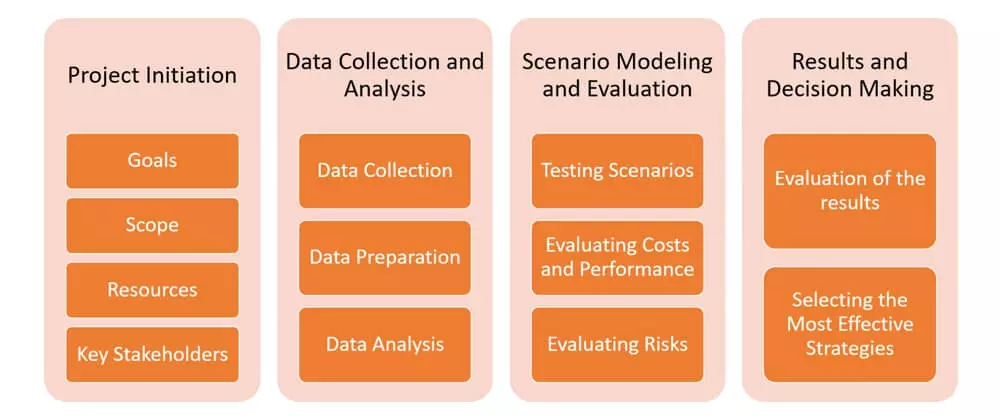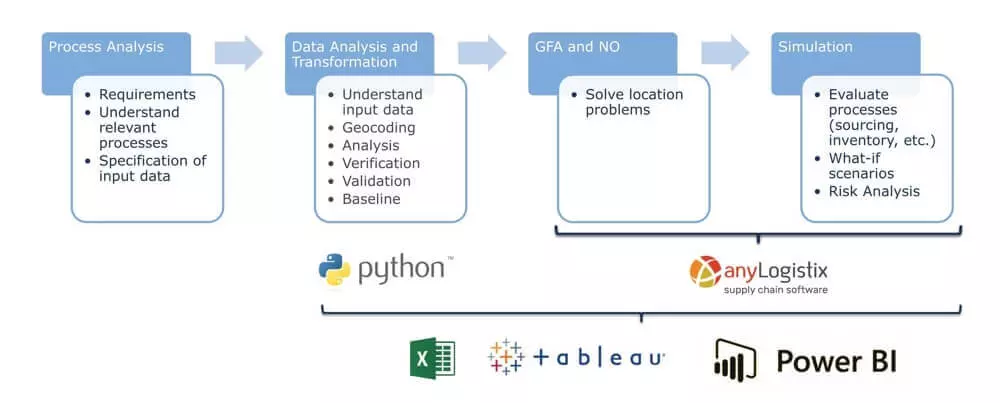
This blog post is partly based on the presentation by Till Fechteler, SimPlan AG, at the anyLogistix Conference 2024.
Efficient decision-making is critical to the success of supply chain projects, where complexities, interdependencies, and uncertainties can significantly impact outcomes. A well-structured project management in the supply chain provides a clear roadmap for identifying objectives, managing resources, and navigating challenges. This ensures that decisions are timely, informed, and aligned with organizational goals.
This article explores how to structure supply chain projects to facilitate decision-making, covering key phases, practical insights, and the role of tools and technology.
Contents:
A structured approach to project management in the supply chain ensures clarity, accountability, and alignment among stakeholders. Without a clear structure, decision-making may lead to delays, inefficiencies, and missed opportunities. Structuring a project provides a framework for:

Benefits of a structured approach to project management in the supply chain
Project management in the supply chain begins with initiation, where goals, scope, and resources are defined, and key stakeholders are identified. This foundational step establishes a shared vision and aligns the team on objectives such as cost reduction, improved service levels, or enhanced sustainability.
The next phase focuses on data collection, preparation and analysis, and converting raw data into actionable insights using tools like Python, Tableau, or Power BI. This data supports scenario modeling and design, where simulations and optimizations are conducted using platforms like anyLogistix.
At the next phase, scenarios are tested to evaluate risks, costs, and performance, enabling the selection of strategies that align with organizational goals.
Once the scenarios are modeled, the project team evaluates the results and selects the most effective strategies in the final phase. This process involves close collaboration among stakeholders to ensure alignment and consensus while also addressing the complexities and unforeseen challenges that frequently arise in real-world projects.

Key phases of structuring supply chain projects
The practical implementation of project management in the supply chain is always more complex than theoretical models, as it involves the unexpected challenges of real-world business scenarios. Till Fechteler from SimPlan AG, a company specializing in simulation-based planning and optimization since 1992, shared his insights on how supply chain projects are structured. His company has completed dozens of simulation modeling projects and developed a proven approach to executing such initiatives effectively.
Every supply chain design project involves distinct phases, each addressing specific aspects of the network.

Phases of a supply chain design project by SimPlan AG
Phase 1. Process Analysis
The first step is to thoroughly understand the supply chain’s processes and requirements.
A clear understanding of processes lays the foundation for data analysis and ensures the model’s accuracy.
Phase 2. Data Analysis and Transformation
The second phase focuses on working with data. This includes collecting, analyzing, and preparing the data for modeling. Key steps include:
This phase sets the stage for modeling and simulation by ensuring clean, structured, and validated data.
Phase 3. Greenfield Analysis and Network Optimization
Once the data is ready, the focus shifts to solving location problems through optimization. Greenfield analysis (GFA) and network optimization in anyLogistix help determine optimal locations for supply chain assets. Typical questions addressed include:
For instance, anyLogistix can model scenarios where the number of hubs is limited, delivery routes are restricted by distance, or trucks must operate within tight scheduling constraints.
Phase 4. Simulation
While optimization focuses on strategic decisions like location selection, simulation evaluates operational aspects of supply chain processes. Simulation is especially useful for:
For example, material flow simulation in anyLogistix can reveal the implications of limited container availability or the need for alternative transportation during high tides.
Tools and Techniques Across Phases
Phase 2: Python for Data Preparation. Python is essential for managing and transforming the large volumes of data involved in supply chain design. It is used to cluster data, validate datasets, and prepare import files for anyLogistix.
Phases 2–4: Tableau, Power BI, and Excel for Evaluation. Data visualization tools like Tableau, Power BI, and Excel are indispensable for analyzing results, identifying trends, and communicating insights to stakeholders.
Phases 3–4: anyLogistix for Modeling and Optimization. anyLogistix helps in phases three and four, where its optimization and simulation capabilities provide critical insights. For instance, optimization models help configure networks, while simulations evaluate operational performance.
Balancing Optimization and Simulation
A central decision in supply chain design is choosing between optimization and simulation, depending on the project’s goals.
By combining both approaches, supply chain projects can address both strategic and operational challenges effectively.
Practical Requirements and Challenges
SimPlan AG frequently encounters the following requirements in its projects:
These scenarios highlight the importance of customized solutions tailored to the unique constraints of each supply chain.
You can watch the full presentation on the insights of project phases in the supply chain by Till Fechteler from SimPlan AG. The slides are available as a PDF.

This article explores the workflow of project management in the supply chain from a practical standpoint. We describe the steps required to align supply chain operations with business objectives while addressing real-world challenges.
Combining a clear structure with advanced software like anyLogistix and data analysis tools enables businesses to make informed, valuable decisions. Tools like anyLogistix bridge the gap between theory and real-world application by providing advanced modeling, simulation, and optimization capabilities. These tools allow businesses to build digital twins of their supply chains, test multiple scenarios, and analyze trade-offs in cost, service levels, and risks.
Structuring supply chain projects effectively is vital for making efficient, high-quality decisions that drive success. In today’s dynamic business environment, where supply chains are constantly exposed to risks and disruptions, a well-structured project not only ensures smoother execution but also provides the agility to adapt and thrive.
Learn more about how anyLogistix can streamline your operations by exploring case studies or contacting our team.